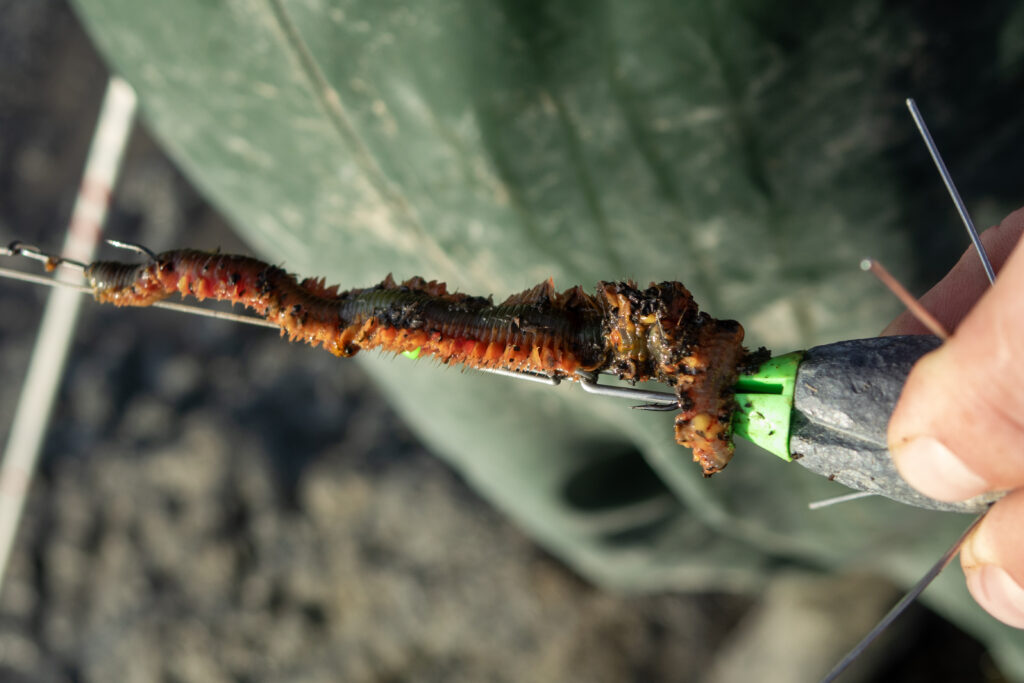Bait clips have evolved massively across the last few decades. The concept has always been the same, and we’ve come a long way since anglers first realised that streamlining a rig would enable it to be cast a far greater distance. The most basic of bait clips can be made by hammering a panel pin in to the side of a lead weight, and although it’s crude, it will work… most of the time.
But most of the time is really not good enough. You want to know that you can cast and the bait remains clipped to the bait clip throughout the cast, only releasing when it is in the water and doing its thing. An unclipped bait, mid-cast, will mean you’re likely to blow up your reel (in the case of a multiplier reel), but even if this doesn’t happen, the sudden resistance on the end tackle as it heads seaward will massively cut your cast down.
Luckily, there are some very clever little gadgets available nowadays that will keep your rigs streamlined in flight and offer a reliable release where it gets to where it’s going.
Let’s take a look at three popular choices.
Breakaway Imp
Like a lot of bait clips, the breakaway Imp holds the baited hook in place until it hits the water at the end of the cast. The Imp is held on the cross section of a clip that also holds the lead. The Breakaway Imp is perfect for smaller baits and will even hold two small baited hooks in the case of a rig such as the bomber. It is a cost effective bait clip that is neat and small, meaning that it is less likely to become snagged up when fishing over rougher ground.
As a lead can be attached directly to the clip, there is no need to tie a lead link to the end of your rig body and it also means that you can swap out a wired lead for a plain lead, or visa-versa as and when required. The Imp enables you to make streamlined rigs and is especially popular with those using multi hook rigs with smaller baits.
The plastic part that actually holds your hook can be a little fiddly to get on to the link itself, but recognising this, Breakaway also produce an Imp assembly tool that makes connecting the two components an absolute doddle.

Gemini Splash Down Solo Clip
These are brilliant and my first choice for any clipped down baits. They are a little more expensive, but because they hold the hook entirely captive throughout the cast, they are pretty fool proof. I started tying Solo clips on to my clients rigs, as the slightly jerky release of the line when cast off of a fixed spool reel can lead to premature release, but I liked them so much that I began using them on my own rigs too.
Again, it’s water pressure that releases the baited hook from its captivation and although the hole that holds the hook appears to be quite small, it will actually hold an 8/0 Varivas Big Mouth Xtra, probably the largest hook I will ever need to use when shore fishing. If you did want to use heavier gauge hooks, a simple oval split rig or a piece of formed lead wire can be looped over the hook and then clipped in to the Solo clip.
Even casting big baits, such as whole mackerel, is possible with the Solo clip. One point of note is that it’s important to give the rig a quick rinse in the water if you’re retrieving it over sand, as any grains that find their way in could jam the release mechanism.

Gemini Big Bait Clip
These are very simple but highly effective and are derived from the basic Gemini Link Clip. The tag end that the lead is slid over has been extended and protrudes by around 10mm, making it perfect for clipping a hook too. These are some of the cheapest bait clips around and are favoured by anglers fishing over extremely rough ground who are looking to keep costs down.
Rather than releasing the baited hook upon impact with the water like the two clips above, these release the hook as the lead touches down on the sea bed, effectively ejecting it. If you’re casting on to soft ground, such as mud, the lead’s landing may be cushioned and might not release the hook. Experience has also found that casting in a side wind could cause the hook to remain clipped down, the bow of line created by the wind keeping everything taught.
That said, the Gemini Big Bait clip remains a favourite when casting in to the really nasty stuff and you’re conscious of the penny’s adding up. They also make a useful rotten bottom device when inverted and the hook clip is used to hold the lead on the cast.


